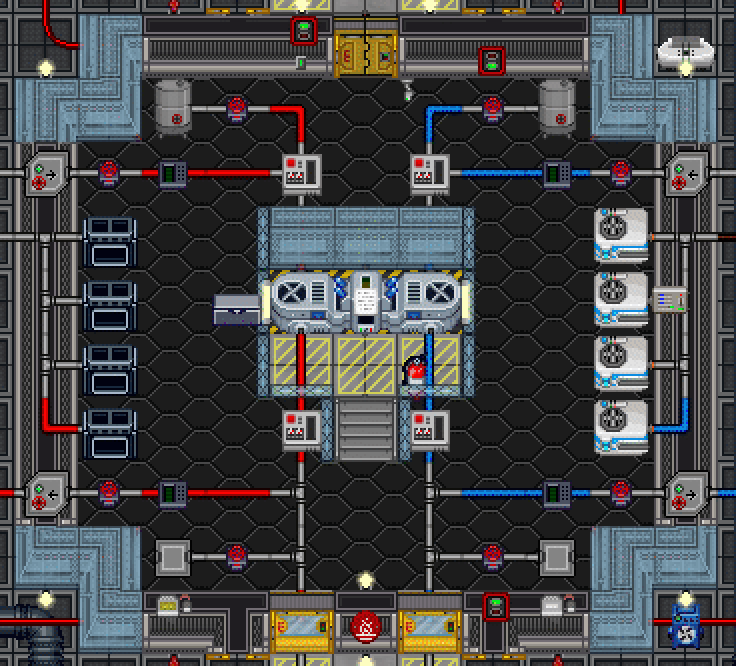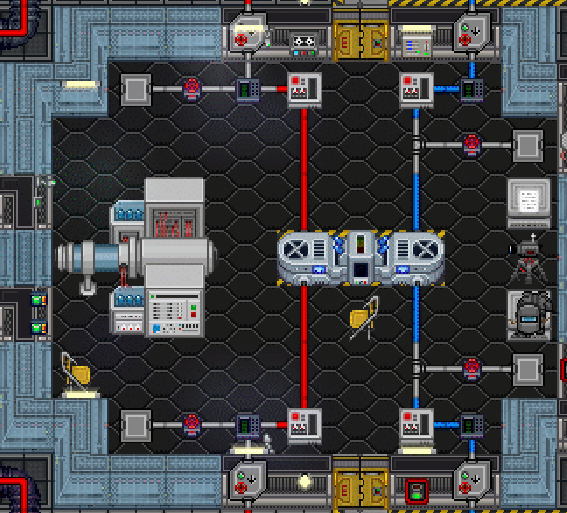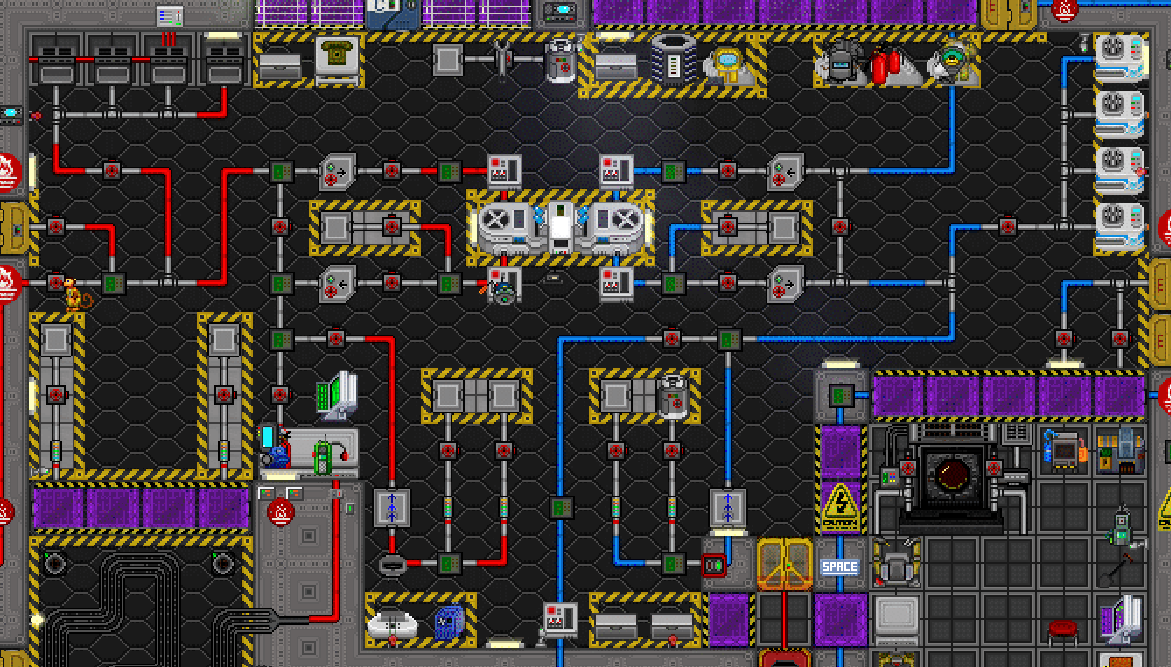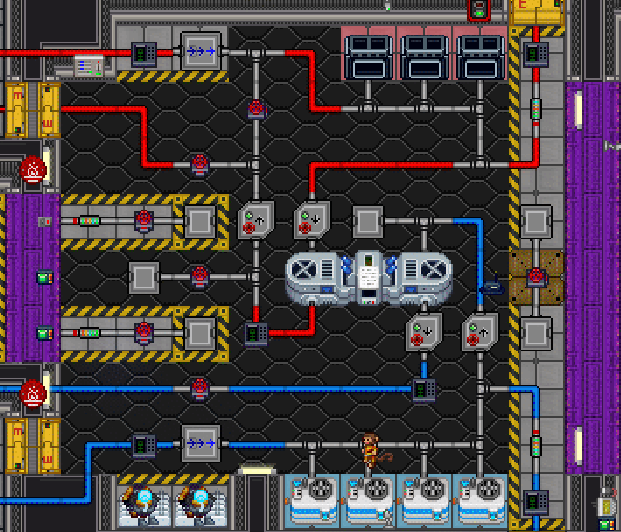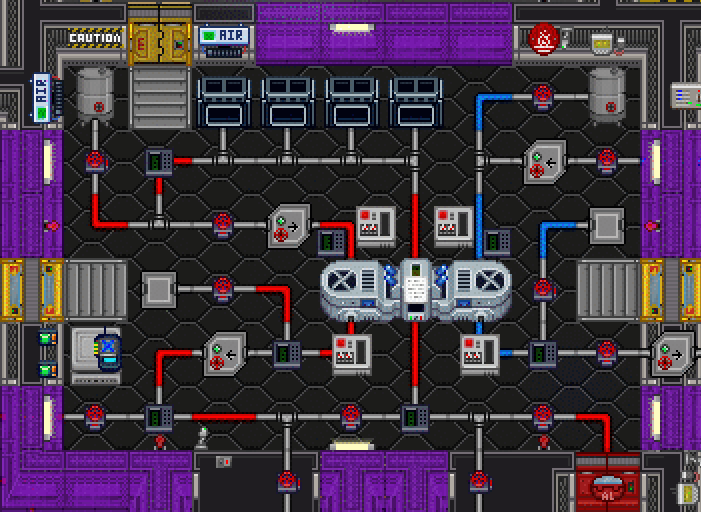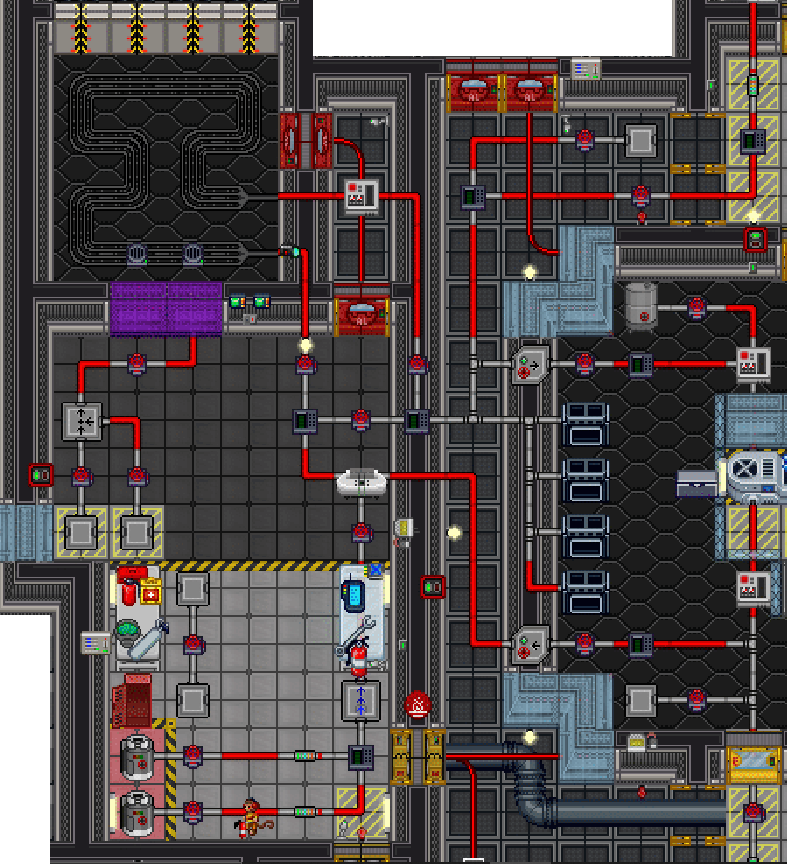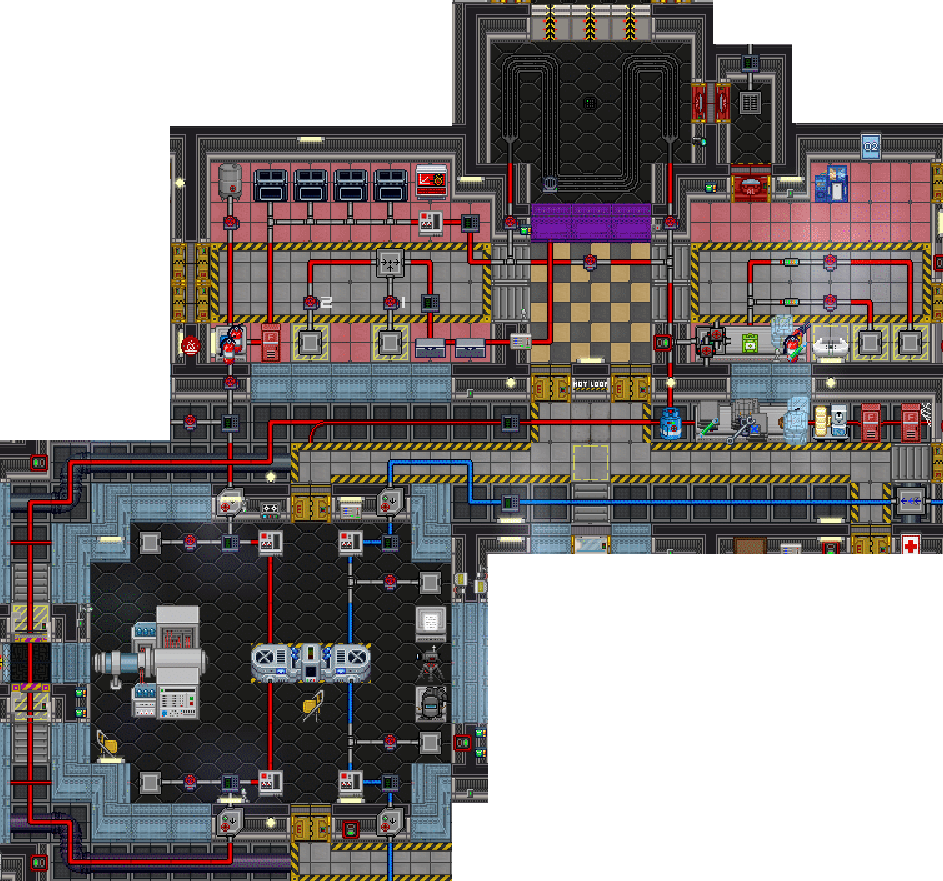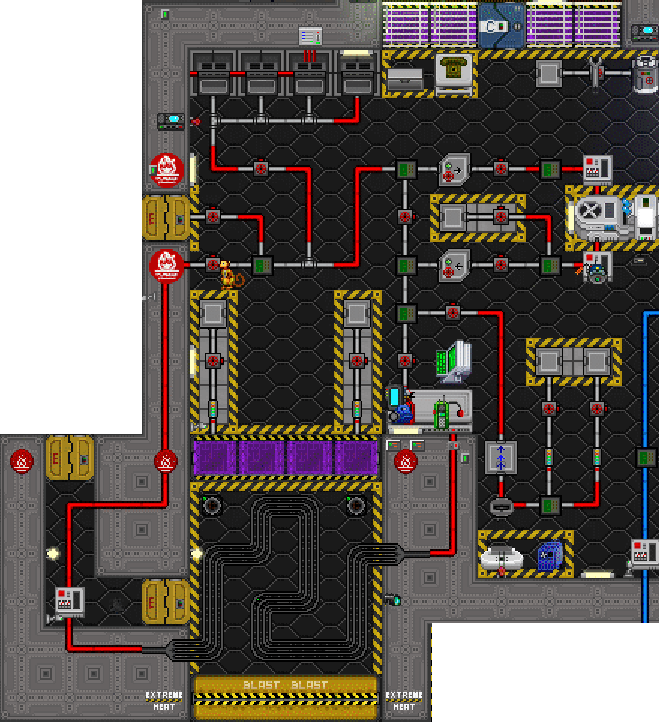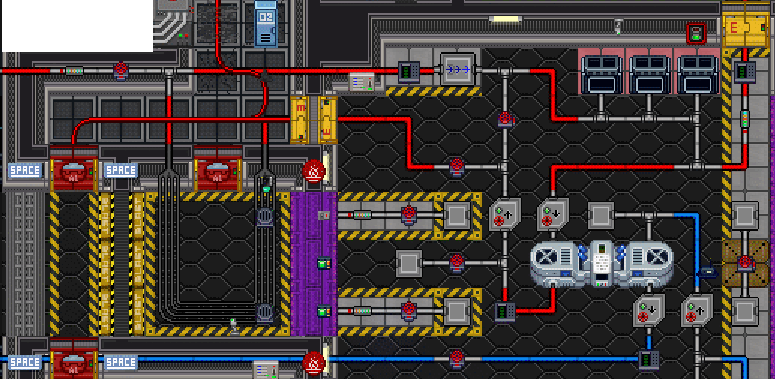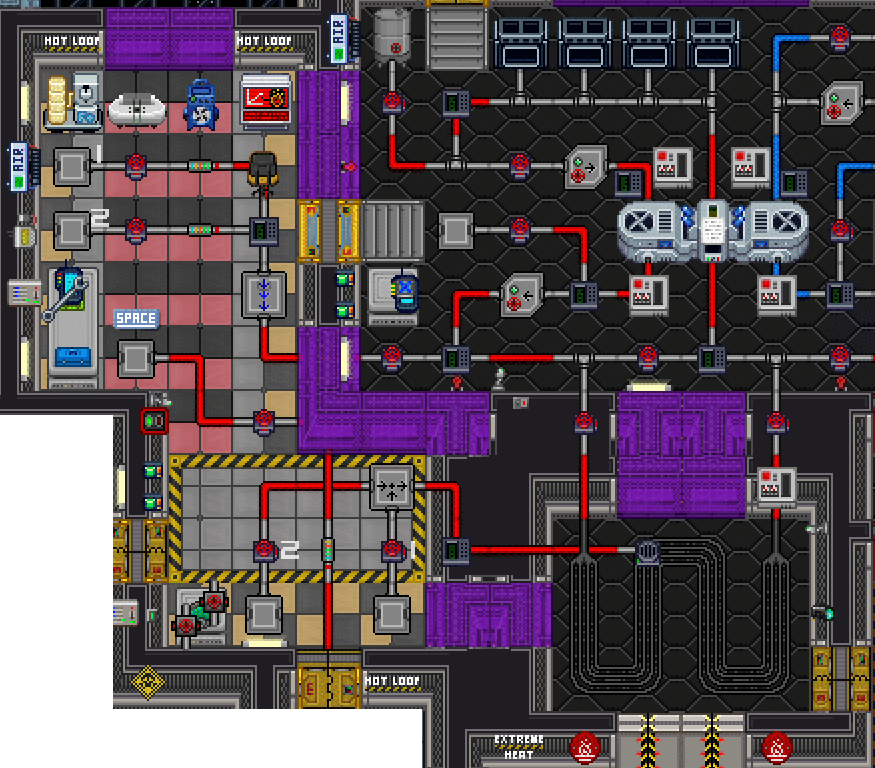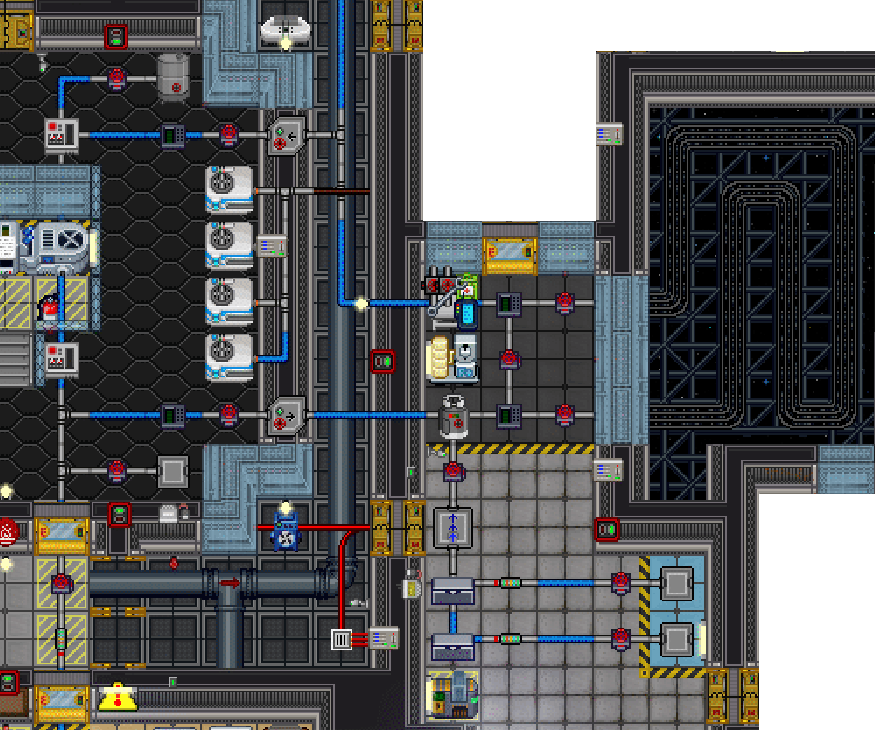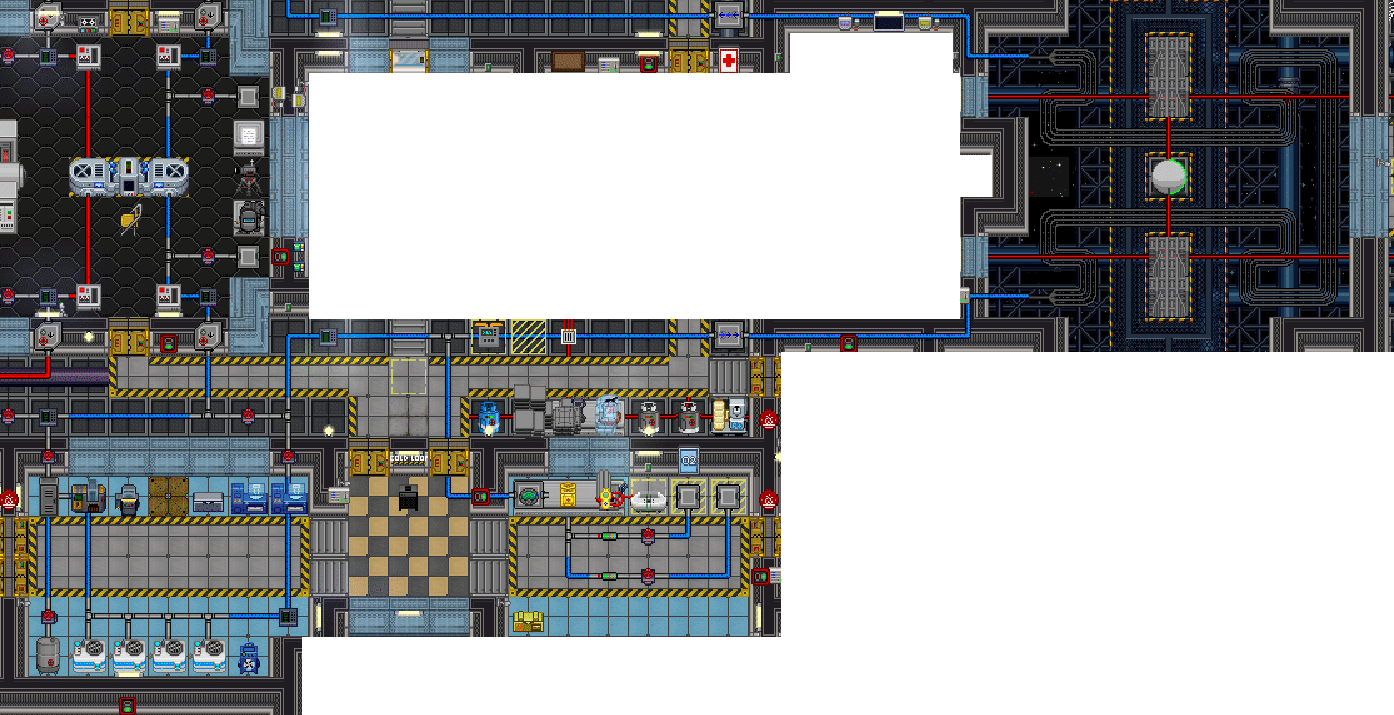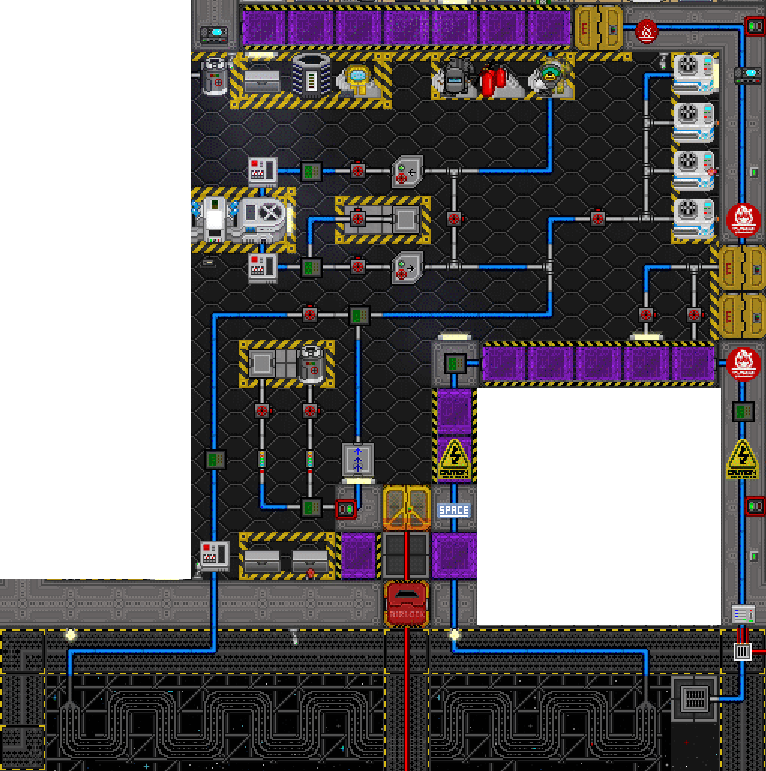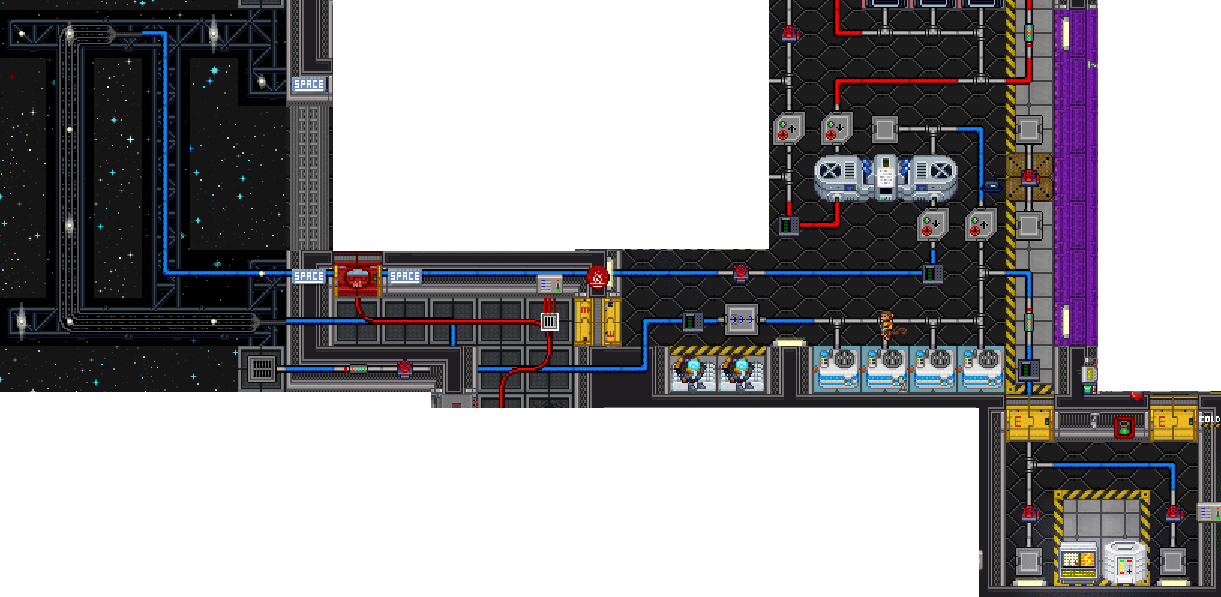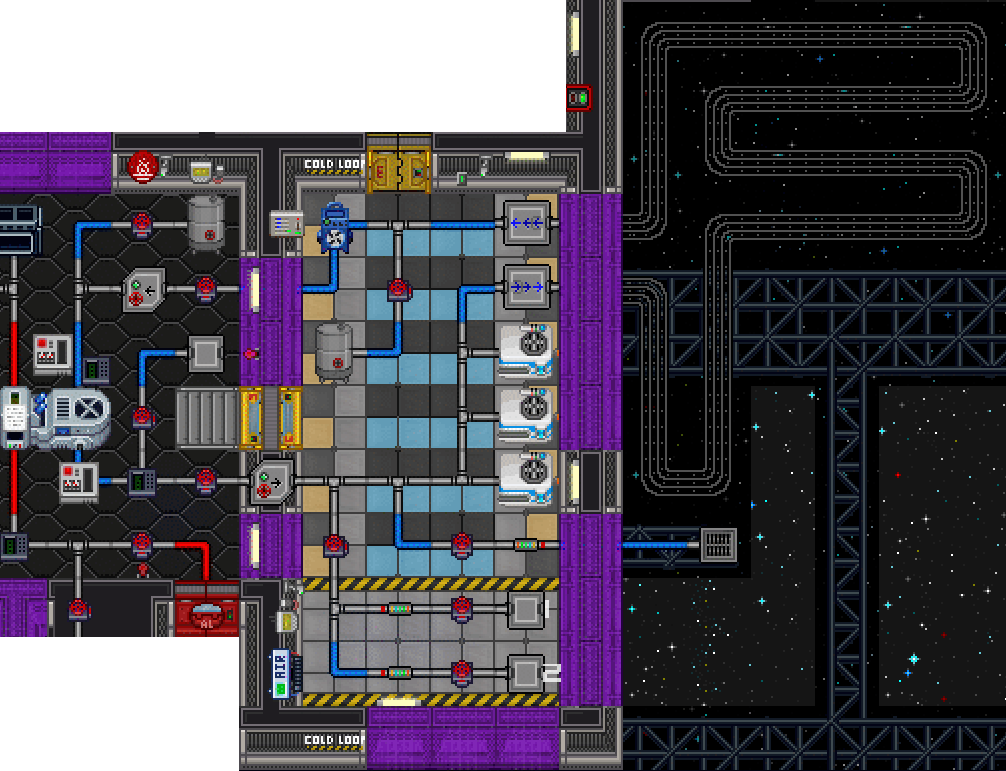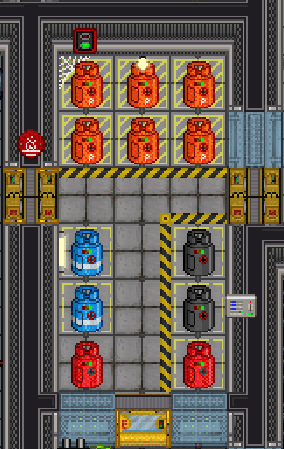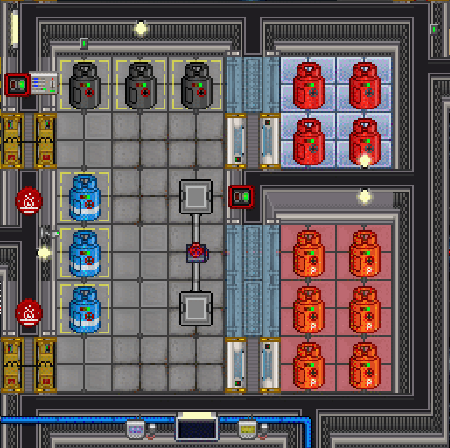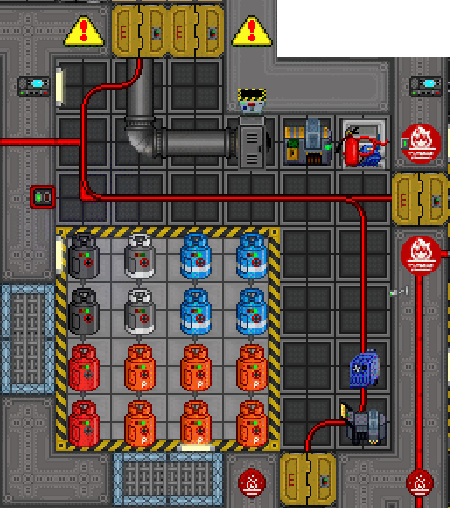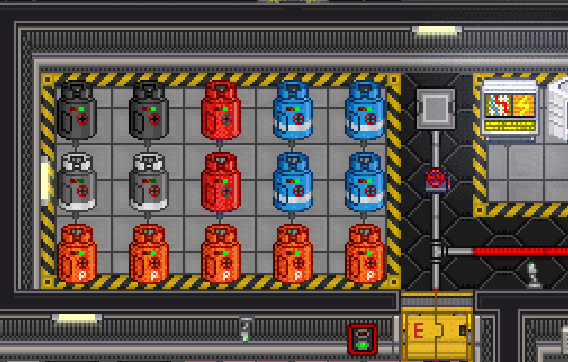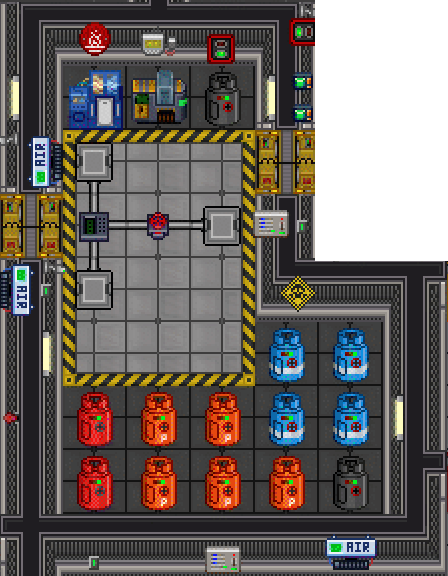Thermoelectric Generator: Difference between revisions
m fixed typo |
→Mechanics: Started mechanics section, defined ideal gas law |
||
| Line 199: | Line 199: | ||
# '''Configure the SMES units''': The engine should be producing power by this point, and so the [[Power_Grid#SMES|SMES units]] will need to be configured to distribute the power. On some maps some of them may be a considerable distance from the engine, and so asking a knowledgeable [[AI]] to set them for you may be helpful. | # '''Configure the SMES units''': The engine should be producing power by this point, and so the [[Power_Grid#SMES|SMES units]] will need to be configured to distribute the power. On some maps some of them may be a considerable distance from the engine, and so asking a knowledgeable [[AI]] to set them for you may be helpful. | ||
==Mechanics== | ==Additional Mechanics== | ||
These are various miscellaneous mechanics about the TEG that are not important for basic setups. However, understanding some or all of these will be immensely helpful in designing TEG solutions that generate impressive power levels or even infinite exponential growth. With the right know-how, you can earn millions of credits from the PTL and even overflow the defined list of metric prefixes for output wattage. If any of this piques your interest, read on. | |||
===Ideal Gas Law=== | ===Ideal Gas Law=== | ||
''Disclaimer: None of this physics knowledge is required in order to be an effective engineer, but it may help you to understand why certain things about the TEG are true and how you may more effectively manipulate it in your favor.'' | |||
Gasses in Space Station 13 roughly obey the ideal gas law, which is a physics equation detailing the behavior of an "ideal" gas: that is, one composed of volumeless particles that do not interact with each other. The ideal gas law is defined as: | |||
Pressure * Volume = Mol Count * the Ideal Gas Constant * Temperature | |||
More simply put, PV = nRT. A further breakdown of each of these values: | |||
* '''Pressure (P)''': This is the force that the gas exerts on its surroundings, measured in pascals. Atmospheric pressure is 101.325 kilopascals, and a pressurized gas canister may be well over 4,000 kilopascals. In the TEG, pressure is your main limiting factor. As you increase temperature, pressure also increases. Above 15,000 kilopascals, the pipes have a chance to burst, releasing dangerous burning plasma and reducing the amount of gas in the pipes. | |||
* '''Volume (V)''': This is the amount of space that the gas occupies, measured in liters. While the pipes of the TEG cannot be built or expanded upon, there are a few ways to increase volume. Opening the valve leading to a pressure tank will allow gas to occupy that tank, which considerably increases the volume of the TEG. Connecting tanks or other things that can hold gas to any auxiliary ports along the gas loop will also increase the volume of the loop. The main benefit of increasing volume is that it decreases pressure without effecting temperature, meaning that your burn can get hotter before needing to worry about the pipes bursting. | |||
* '''Mol Count (n)''': A mole is a specific number of things, in this case gas particles. Adding more gas to the loops increases its mol count. This increases the amount of thermal energy that can be transferred (and thus the amount of power that is generated), but also increases pressure. Therefore, adding too much gas to the loops (especially the hot loop) will cause the pipes to break. | |||
* '''The Ideal Gas Constant (R)''': A constant multiplier that is a part of the ideal gas formula. This is a physics constant, and so nothing can be done to change it. In real life, the ideal gas constant has 15 significant figures, but for computational simplicity in Space Station 13 it only has three. It is equal to 8.31. | |||
* '''Temperature (T)''': The average thermal energy of the gas, measured in kelvins. Your goal with the TEG is to optimize for the maximum possible temperature in the hot loop and (much less importantly) the minimum possible temperature in the cold loop. Pressure scales directly with temperature times mol count, meaning that temperature growth causes a corresponding growth in pressure. | |||
====Managing Pressure==== | ====Managing Pressure==== | ||
Revision as of 20:40, 24 October 2022
| This page is under construction. The following information may be incomplete. Pending construction as part of a phasing out of Powering_the_station (yes, its capitalization was inconsistent) for a less wrong engineering guide. |
The thermoelectric generator (TEG) is the main source of power on Cogmap1, Cogmap2, Clarion, Atlas, and Kondaru. It generates power via the thermal interaction of hot gas and cold gas inside the generator. In order to create and maintain a supply of hot and cold gas, two separate loops of gas pipes move through the TEG: The hot loop and the cold loop. As their names imply, the hot loop has equipment designed to heat up the gas within, and the cold loop has equipment designed to cool down the gas within.
Parts of the TEG
Core
The TEG core itself is what makes the electricity. It functions by taking a part of the heat energy conducted between the hot loop and cold loop and converting it into electrical power. The central part of the TEG contains a status terminal, which can give you stats on the current power output, the pressure of the inlet and outlet of both gas loops, and the temperature of both gas loops. The graphic displayed on this terminal represents the current power generation of the TEG. Even the graphics that seem to indicate danger, like skulls and explosions, are only indicative of power output and are not a cause for concern.
The TEG core also features some warning lights next to the blowers. These lights will be blue when blower status is nominal. If the blowers are consuming more power than the APC is receiving, the lights will turn yellow when power is expected to fail within the next five minutes, and will turn red when power is expected to fail in one minute. Due to the questionable math involved in power calculations, the lights turning yellow should not be cause for any concern unless it does not turn blue again after a minute or so.
Blowers
The turbines on the left and right sides of the TEG are gas blowers designed to help increase the flow of gas through the TEG. Using a multitool, their target minimum pressure can be set, and they can be turned on and off. While on, the blower will attempt to pull gas through the pipe in order to maintain at least as much outlet pressure as the specified value. They consume power from the local APC while active, with the power draw being determined by the the difference between the outlet pressure and the inlet pressure. Larger pressure differentials require more power to push gas against.
Lubricant
The maintenance panel on the blowers can be accessed by using a screwdriver on them. Each blower contains a lubricant tank, which starts filled with 200 units of oil. The lubricant tanks can be emptied by using a wrench on them to open the drain caps, which will leak the existing lubricant onto the floor. Remember to close the drain caps before adding new lubricant in order to not waste it.
The quality of the lubricant effects how effectively and power-efficiently the blowers are able to operate against a pressure differential, with more slippery chemicals such as space lube and organic superlubricant providing greater efficiency. The total blower boost from the lubricant is based on the quantity and quality of the lube, meaning that filling the blowers to capacity will be more effective.
Other chemicals may do even more things aside from just lubricating the blowers. For example, pyrosium or cryostylane reacting with oxygen in the blowers will change the temperature of the gas that passes through the blower.
Semiconductor
Inside the central piece of the TEG is a prototype semiconductor, which can be removed by using a screwdriver, then wirecutters, then a crowbar on the TEG. After being removed, the semiconductor can be plated in another material using the arc electroplater, which will change how efficiently the TEG extracts electrical power from the heat exchange. For optimal engine performance, a semiconductor that is electrically conductive and thermally insulative is ideal. To re-add the semiconductor to the engine, use the semiconductor, then wires, then wire cutters, then a screwdriver.
Hot Loop
The hot loop is all of the pipeworks and equipment dedicated to heating gas and pushing it through the TEG. It features two gas tank ports designed to inject plasma into the hot loop pipes for the purpose of conducting thermal energy. In order to raise the temperature of the gas, the hot loop comes equipped with furnaces and a burn chamber. The hot loop pipes are a distinct red color, as are the floor tiles in most hot loop rooms.
Furnaces
The furnaces can accept any flammable solid as fuel. The most readily available is char, but plasmastone, weed, paper, and even corpses can be used as fuel. Different types of fuel do not burn hotter, though more flammable things will fill up the furnace more than less flammable things. The furnace heats to roughly 3200 kelvin when full, and starts to notably drop off in temperature when less than 2/3 full.
Do note that the furnaces attempt to force the gas in the loops towards their output temperature, regardless of whether this means heating the gas or cooling it. If you have a decently hot chamber burn running, running the furnaces will actually cool your hot loop down.
Burn Chamber
The burn chamber is the other method of generating heat in the hot loop. Using the combustion of plasma and oxygen over a hot loop radiator, it can create significantly higher temperatures than the furnaces are capable of. Like the hot loop pipes, the burn chamber has two gas tank ports designed to add gas to the chamber. Unlike the pipes however; these connector ports feed into a special gas mixer pump before reaching the burn chamber. Using the associated mixer pump control terminal, you can set the ratio of the contents of the two gas tanks and the pressure at which they are released into the burn chamber. While experimental burns may benefit from more precise mixer settings, leaving the pump set to a 1:1 ratio of oxygen and plasma at atmospheric pressure (101.325kPa) will ensure a long-lasting and hot burn.
Do note that the burn chamber is not perfectly insulated. A particularly hot burn will heat up the chamber walls, causing heat to conduct out of the chamber and into the surrounding areas. While the heat shields button to deploy shields over the observation windows may help somewhat, it is common practice to use an RCD to cut holes in the floor of the surrounding rooms, venting the engine room and preventing it from spreading dangerously hot gas to the rest of the station.
Cold Loop
The hot loop is all of the pipeworks and equipment dedicated to cooling gas and pushing it through the TEG. It features two gas tank ports designed to inject plasma into the hot loop pipes for the purpose of dissipating thermal energy. In order to lower the temperature of the gas, the cold loop comes equipped with a space radiator and coolers. The cold loop pipes are a distinct blue color, as are the floor tiles in most cold loop rooms.
Space Radiator
A section of the cold loop exits the station in order to flow through radiator pipes in outer space. Due to the extreme cold of space (2.7 degrees above absolute zero, to be exact), this radiator is able to cool the gas in order to dispose of the energy transferred into it by the hot loop. There is nothing user-configurable about the radiator, other than making sure to open the valves so the gas can actually reach it.
Coolers
Something of a counterpart to the hot loop's furnaces, the coolers expend electricity in order to lower the temperature of the cold loop. They can cool the cold loop down to a minimum of 70.3 degrees kelvin, or -200 degrees celsius. Like the furnaces the coolers will attempt to force the gas in the loops towards their output temperature, regardless of whether this means cooling the gas or heating it. Unless the cold loop is absorbing enough energy to keep it above -200 degrees celsius, turning on the coolers will actually warm the cold loop up.
Gas Storage
Gas storage is where all of the canisters of gas that you may or may not need in order to run the engine are stored. It also contains some other helpful equipment, such as air scrubbers and the gas extractor.
Plasma
The blood of a functioning engine. Plasma has an absurd heat capacity compared to other gasses, making it extremely efficient for moving thermal energy through the pipes. It is also quite flammable in the presence of gaseous oxygen, which makes it vital in the burn chamber too. However, plasma's volatility means that if hot plasma were to escape from a ruptured pipe, it would combust rapidly in the air and lead to a massive fire in the engine room.
Oxygen
The stuff you breathe, and also vital for combustion to happen. If you are running the burn chamber, you will need some of this alongside plasma in order to get an actual fire.
Nitrogen
The other stuff you breathe, and also vital for literally nothing. Perhaps an NT executive mistook some of these useless red canisters for the extremely useful orange canisters of plasma, causing them to be included in the engine gas storage room by accident. This gas has no use at all, and has a terrible heat capacity.
Carbon Dioxide
This invisible, asphyxiating gas has no usage in combustion and has a subpar heat capacity, though certain "motivated" crew members may find some use for it as an area-denial weapon with a bit more subtlety than a full-on plasma flood. It is more commonly seen as a byproduct of combustion in the burn chamber, where managing carbon dioxide through usage of the chamber exhaust vents or other means is important to ensure that it does not smother the burn and extinguish it.
Basic Startup Procedure
The purpose of the following two startup guides are to offer a simple explanation of how the engine may be set up to generate power. These setups are by no means even close to optimal, and instead favor stability and ease-of-setup.
Furnace Burn
These steps will guide you through how to make a basic char burn in the furnaces. If the round lasts longer than 45 minutes or so, the furnaces may need refueling to maintain output levels.
- Light the furnaces: Locate the fuel crates full of char somewhere in the engine, and bring the char to the furnaces. Fill each furnace full of char and turn them on.
- Connect the plasma tanks: Locate plasma tanks from gas storage. Connect two tanks to the hot loop connector ports and two tanks to the cold loop connector ports by using a wrench on them.
- Turn the valves: Turn valves so that the flowing gas has an available path from the connector ports in order to flow through the TEG. Make sure to turn any valve needed for the gas to reach the furnaces and space radiator too, as some TEGs have bypass valves that allow you to prevent gas from reaching these equipment. Avoid turning the gas purge valves, as these lead to a vent in space and are meant for emptying the pipes of gas.
- Configure the blowers: Use a multitool on a blower on the side of the TEG to access its configuration menu. Set its target pressure to 1000kPa, and activate it. Repeat for the other blower.
- Configure the SMES units: The engine should be producing power by this point, and so the SMES units will need to be configured to distribute the power. On some maps some of them may be a considerable distance from the engine, and so asking a knowledgeable AI to set them for you may be helpful.
Chamber Burn
These steps will guide you through how to make a basic plasma burn in the burn chamber.
- Connect the plasma tanks: Locate plasma tanks from gas storage. Connect one tank to the hot loop connector port and two tanks to the cold loop connector ports by using a wrench on them. Connecting two tanks may cause the pipes to burst from overpressure.
- Turn the valves: Turn valves so that the flowing gas has an available path from the connector ports in order to flow through the TEG. Make sure to turn any valve needed for the gas to reach the burn chamber and space radiator too, as some TEGs have bypass valves that allow you to prevent gas from reaching these equipment. Avoid turning the gas purge valves, as these lead to a vent in space and are meant for emptying the pipes of gas.
- Light the chamber: Connect a plasma tank and an oxygen tank to the burn chamber connector ports, and open the chamber fuel valves. Find the mixer pump control terminal (a computer with a whiteish screen, usually near the other computers) and turn on the mixer pump. Leave the gas ratio and pressure to their default values (50%:50%, 101.325kPa). After allowing the gas to enter the chamber for a few seconds, locate the ignition switch to create a spark to ignite the gas. If the fire stays in place and does not spread, throw the ignition switch again.
- Configure the blowers: Use a multitool on a blower on the side of the TEG to access its configuration menu. Set its target pressure to 1000kPa, and activate it. Repeat for the other blower.
- Configure the SMES units: The engine should be producing power by this point, and so the SMES units will need to be configured to distribute the power. On some maps some of them may be a considerable distance from the engine, and so asking a knowledgeable AI to set them for you may be helpful.
Additional Mechanics
These are various miscellaneous mechanics about the TEG that are not important for basic setups. However, understanding some or all of these will be immensely helpful in designing TEG solutions that generate impressive power levels or even infinite exponential growth. With the right know-how, you can earn millions of credits from the PTL and even overflow the defined list of metric prefixes for output wattage. If any of this piques your interest, read on.
Ideal Gas Law
Disclaimer: None of this physics knowledge is required in order to be an effective engineer, but it may help you to understand why certain things about the TEG are true and how you may more effectively manipulate it in your favor.
Gasses in Space Station 13 roughly obey the ideal gas law, which is a physics equation detailing the behavior of an "ideal" gas: that is, one composed of volumeless particles that do not interact with each other. The ideal gas law is defined as:
Pressure * Volume = Mol Count * the Ideal Gas Constant * Temperature
More simply put, PV = nRT. A further breakdown of each of these values:
- Pressure (P): This is the force that the gas exerts on its surroundings, measured in pascals. Atmospheric pressure is 101.325 kilopascals, and a pressurized gas canister may be well over 4,000 kilopascals. In the TEG, pressure is your main limiting factor. As you increase temperature, pressure also increases. Above 15,000 kilopascals, the pipes have a chance to burst, releasing dangerous burning plasma and reducing the amount of gas in the pipes.
- Volume (V): This is the amount of space that the gas occupies, measured in liters. While the pipes of the TEG cannot be built or expanded upon, there are a few ways to increase volume. Opening the valve leading to a pressure tank will allow gas to occupy that tank, which considerably increases the volume of the TEG. Connecting tanks or other things that can hold gas to any auxiliary ports along the gas loop will also increase the volume of the loop. The main benefit of increasing volume is that it decreases pressure without effecting temperature, meaning that your burn can get hotter before needing to worry about the pipes bursting.
- Mol Count (n): A mole is a specific number of things, in this case gas particles. Adding more gas to the loops increases its mol count. This increases the amount of thermal energy that can be transferred (and thus the amount of power that is generated), but also increases pressure. Therefore, adding too much gas to the loops (especially the hot loop) will cause the pipes to break.
- The Ideal Gas Constant (R): A constant multiplier that is a part of the ideal gas formula. This is a physics constant, and so nothing can be done to change it. In real life, the ideal gas constant has 15 significant figures, but for computational simplicity in Space Station 13 it only has three. It is equal to 8.31.
- Temperature (T): The average thermal energy of the gas, measured in kelvins. Your goal with the TEG is to optimize for the maximum possible temperature in the hot loop and (much less importantly) the minimum possible temperature in the cold loop. Pressure scales directly with temperature times mol count, meaning that temperature growth causes a corresponding growth in pressure.

